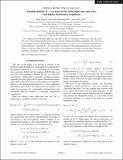| dc.contributor.author | Cheng, Shan | |
| dc.contributor.author | Khodjamirian, Alexander | |
| dc.contributor.author | Virto, Javier | |
| dc.date.accessioned | 2018-02-12T21:34:54Z | |
| dc.date.available | 2018-02-12T21:34:54Z | |
| dc.date.issued | 2017-09 | |
| dc.date.submitted | 2017-08 | |
| dc.identifier.issn | 2470-0010 | |
| dc.identifier.issn | 2470-0029 | |
| dc.identifier.uri | http://hdl.handle.net/1721.1/113609 | |
| dc.description.abstract | We complete the set of QCD light-cone sum rules for B→ππ transition form factors, deriving a new sum rule for the timelike-helicity form factor F[subscript t] in terms of dipion distribution amplitudes. This sum rule, in the leading twist-two approximation, is directly related to the pion vector form factor. Employing a relation between F[subscript t] and other B→ππ form factors, we obtain also the longitudinal-helicity form factor F[subscript 0]. In this way, all four (axial-)vector B→ππ form factors are predicted from light-cone sum rules with dipion distribution amplitudes. These results are valid for small dipion masses with large momentum. | en_US |
| dc.description.sponsorship | Swiss National Science Foundation | en_US |
| dc.description.sponsorship | Horizon 2020 Framework Programme (European Commission) (Marie Sklodowska-Curie Grant Agreement 700525 NIOBE) | en_US |
| dc.description.sponsorship | Explora (Project FPA2014-61478-EXP) | en_US |
| dc.publisher | American Physical Society | en_US |
| dc.relation.isversionof | http://dx.doi.org/10.1103/PhysRevD.96.051901 | en_US |
| dc.rights | Article is made available in accordance with the publisher's policy and may be subject to US copyright law. Please refer to the publisher's site for terms of use. | en_US |
| dc.source | American Physical Society | en_US |
| dc.title | Timelike-helicity y B → ππ form factor from light-cone sum rules with dipion distribution amplitudes | en_US |
| dc.type | Article | en_US |
| dc.identifier.citation | Cheng, Shan, et al. “Timelike-Helicity B → π π Form Factor from Light-Cone Sum Rules with Dipion Distribution Amplitudes.” Physical Review D, vol. 96, no. 5, Sept. 2017. © 2017 American Physical Society | en_US |
| dc.contributor.department | Massachusetts Institute of Technology. Center for Theoretical Physics | en_US |
| dc.contributor.department | Massachusetts Institute of Technology. Department of Physics | en_US |
| dc.contributor.mitauthor | Virto, Javier | |
| dc.relation.journal | Physical Review D | en_US |
| dc.eprint.version | Final published version | en_US |
| dc.type.uri | http://purl.org/eprint/type/JournalArticle | en_US |
| eprint.status | http://purl.org/eprint/status/PeerReviewed | en_US |
| dc.date.updated | 2017-11-14T22:45:32Z | |
| dc.language.rfc3066 | en | |
| dc.rights.holder | American Physical Society | |
| dspace.orderedauthors | Cheng, Shan; Khodjamirian, Alexander; Virto, Javier | en_US |
| dspace.embargo.terms | N | en_US |
| mit.license | PUBLISHER_POLICY | en_US |
